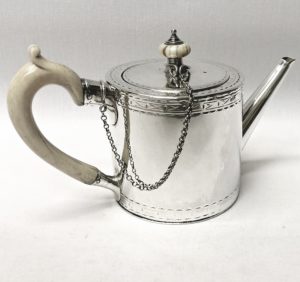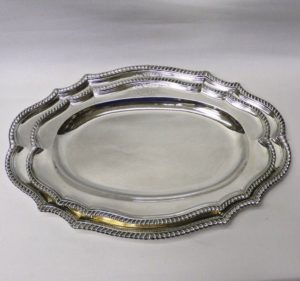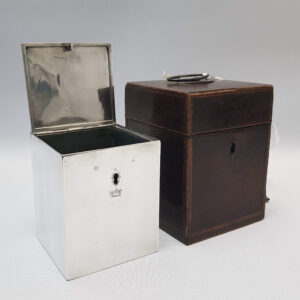John Parker & Edward Wakelin
Edward Wakelin, apprenticed to John le Sage June 1730, free 1748. By 1747 he had joined the famous George Wickes at Panton Street, entered his first mark (2 sizes) which was almost indistinguishable from the mark of George Wickes, and during the period 1747-1760 Wakelin took virtual charge of the silver side of Wickes’ business. By 1752, Wickes was already making retirement plans although the formal date of the hand over to Wakelin, and his new partner, John Parker I was dated 1760.
Wakelin, in partnership with John Parker I, entered a new mark circa 1758-1761 where Parker’s initials appear above Wakelin’s, suggesting that he became the senior partner at this point. John Parker I and Edward Wakelin retired in 1777 and the business was continued by John Wakelin, Edward’s son, and William Taylor.
Edward Wakelin was a man of extraordinary business acumen. He bought into an established business and possessed the ability to ensure its continued success. He employed talented, but mainly anonymous silversmiths at Panton Street, outsourcing what he was unable to make. Two of these highly skilled silversmiths were James Ansill and Stephen Gilbert, former apprentices of George Wickes, who never entered a mark while working for Parker and Wakelin, but in 1780 Stephen Gilbert entered a mark in partnership with Andrew Fogelberg that continued until 1793. It is highly probable that Sebastian and James Crespel learnt their trade under Edward Wakelin and there was a definite financial connection between the Crespels and Wakelin and Parker.
John Parker & Edward Wakelin
Edward Wakelin, apprenticed to John le Sage June 1730, free 1748. By 1747 he had joined the famous George Wickes at Panton Street, entered his first mark (2 sizes) which was almost indistinguishable from the mark of George Wickes, and during the period 1747-1760 Wakelin took virtual charge of the silver side of Wickes’ business. By 1752, Wickes was already making retirement plans although the formal date of the hand over to Wakelin, and his new partner, John Parker I was dated 1760.
Wakelin, in partnership with John Parker I, entered a new mark circa 1758-1761 where Parker’s initials appear above Wakelin’s, suggesting that he became the senior partner at this point. John Parker I and Edward Wakelin retired in 1777 and the business was continued by John Wakelin, Edward’s son, and William Taylor.
Edward Wakelin was a man of extraordinary business acumen. He bought into an established business and possessed the ability to ensure its continued success. He employed talented, but mainly anonymous silversmiths at Panton Street, outsourcing what he was unable to make. Two of these highly skilled silversmiths were James Ansill and Stephen Gilbert, former apprentices of George Wickes, who never entered a mark while working for Parker and Wakelin, but in 1780 Stephen Gilbert entered a mark in partnership with Andrew Fogelberg that continued until 1793. It is highly probable that Sebastian and James Crespel learnt their trade under Edward Wakelin and there was a definite financial connection between the Crespels and Wakelin and Parker.
-


1775
John Parker & Edward Wakelin
8752 George III Silver Drum Teapot
Sold
An antique sterling silver teapot of circular form having a detachable lid attached to the body with a silver chain. Drum teapots are very desirable and are usually found between 1760 and 1780. Lovely plain styling with discreet bands of hand engraved geometric decoration. Underneath there are some initials and a scratch weight.Contains 465 ml. Weight 319 grams, 10.2 troy ounces. Height 11.5 cms. Spread 19.5 cms. Base diameter 9 cms. London 1775. Maker Parker & Wakelin.
-


1770
John Parker & Edward Wakelin
8138 Georgian Oval Platters
Sold
An excellent pair of antique sterling silver serving dishes of shaped oval form with crisp gadroon borders. Engraved to the front there is a fine armorial, the motto reading “Finem respice” which means “look to the end”; we are told that these are the arms of John Bligh, the 3rd Earl of Darnley. Of staggered size, the medium platter nests perfectly inside the larger platter. Weight 2166 grams (69.6 troy ounces). The larger platter measures 44.5 x 31.5 cms. The medium platter measures 39 x 26.5 cms. London 1770. Maker Parker & Wakelin.
-


Circa 1770
John Parker & Edward Wakelin
10386 George III Antique Silver Tea Caddy
Sold
A delightful antique silver tea box of plain cubic design with a flat hinged lid. The cannister form has very pleasing geometric lines. The top is charmingly decorated with a hand engraved border with shell corners, the finial is modelled as a pineapple. To the front is a locking mechanism (key available) and a hand engraved crest. An attractive feature is the fitted mahogany wooden box with colourful inlaid bands to the edges. Weight 303g, 9.7 troy oz. Height 12cm. Length 8.9cm. Width 8.9cm. London 1768. Maker Parker & Wakelin. Sterling silver.